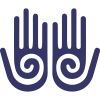The main principle in Thai massage is non-harming. The reason I need to say this is that in my practice I see a lot of people and also meet with their expectations. Let me explain.
Little is known for the early days of Thai massage as it is an ancient art – it has been around for over 2,500 years. Legend has it that the founder of Thai yoga massage was actually a doctor from northern India, who has never set his foot in Thailand. His name was Jivaka Kumar Bhaccha. He was a contemporary and, according to some sources, a friend of the Buddha and personal physician to the Magadha King Bimbisara.
Thai massage and Buddhism
This legend may be true or not. Nevertheless, Thai yoga massage is connected to yogic philosophy and is deeply rooted spirituality and especially in Buddhism. Until fairly recently, it was practiced and taught predominantly in Buddhist temples in Thailand.
The main principle in Thai massage is non-harming
The Sanskrit word for that is Ahimsa. It means lack of violence and is an ethical principle in Hinduism and Buddhism of not causing harm in all aspects of life, in thought, word or deed. This means not harming others or ourselves, or nature. If we carefully consider this principle, we see that it is far reaching.
The need to apply this principle in massage is obvious. What we want from a treatment is to increase wellbeing, not to stress or harm or inflict pain. Ahimsa also means not aggravating or contributing to an issue that is already present.
So if somebody limps into my treatment room and asks for deep stretches, coming from a place of Ahimsa I would rather choose to give them a massage that I think will be helpful and nurturing and won’t risk making them feel worse the next day.
I would rather take the disappointment than cause them harm.
Related articles:
For our body to heal, we have to be in a healing state
6 ways Thai yoga massage can help you



